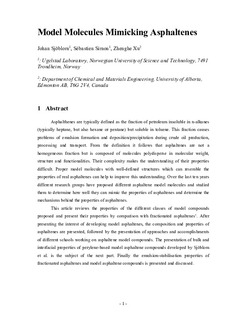| dc.contributor.author | Sjøblom, Johan | |
| dc.contributor.author | Simon, Sebastien Charles | |
| dc.contributor.author | Xu, Zhenghe | |
| dc.date.accessioned | 2018-01-23T11:24:43Z | |
| dc.date.available | 2018-01-23T11:24:43Z | |
| dc.date.created | 2015-06-23T13:32:44Z | |
| dc.date.issued | 2015 | |
| dc.identifier.citation | Advances in Colloid and Interface Science. 2015, 218 1-16. | nb_NO |
| dc.identifier.issn | 0001-8686 | |
| dc.identifier.uri | http://hdl.handle.net/11250/2479019 | |
| dc.description.abstract | Asphalthenes are typically defined as the fraction of petroleum insoluble in n-alkanes (typically heptane, but also hexane or pentane) but soluble in toluene. This fraction causes problems of emulsion formation and deposition/precipitation during crude oil production, processing and transport. From the definition it follows that asphaltenes are not a homogeneous fraction but is composed of molecules polydisperse in molecular weight, structure and functionalities. Their complexity makes the understanding of their properties difficult. Proper model molecules with well-defined structures which can resemble the properties of real asphaltenes can help to improve this understanding. Over the last ten years different research groups have proposed different asphaltene model molecules and studied them to determine how well they can mimic the properties of asphaltenes and determine the mechanisms behind the properties of asphaltenes.
This article reviews the properties of the different classes of model compounds proposed and present their properties by comparison with fractionated asphaltenes. After presenting the interest of developing model asphaltenes, the composition and properties of asphaltenes are presented, followed by the presentation of approaches and accomplishments of different schools working on asphaltene model compounds. The presentation of bulk and interfacial properties of perylene-based model asphaltene compounds developed by Sjöblom et al. is the subject of the next part. Finally the emulsion-stabilization properties of fractionated asphaltenes and model asphaltene compounds is presented and discussed. | nb_NO |
| dc.language.iso | eng | nb_NO |
| dc.publisher | Elsevier | nb_NO |
| dc.rights | Attribution-NonCommercial-NoDerivatives 4.0 Internasjonal | * |
| dc.rights.uri | http://creativecommons.org/licenses/by-nc-nd/4.0/deed.no | * |
| dc.title | Model molecules mimicking asphaltenes | nb_NO |
| dc.type | Journal article | nb_NO |
| dc.type | Peer reviewed | nb_NO |
| dc.description.version | acceptedVersion | nb_NO |
| dc.source.pagenumber | 1-16 | nb_NO |
| dc.source.volume | 218 | nb_NO |
| dc.source.journal | Advances in Colloid and Interface Science | nb_NO |
| dc.identifier.doi | 10.1016/j.cis.2015.01.002 | |
| dc.identifier.cristin | 1250223 | |
| dc.relation.project | Norges forskningsråd: 234112 | nb_NO |
| dc.description.localcode | © 2015. This is the authors’ accepted and refereed manuscript to the article. This manuscript version is made available under the CC-BY-NC-ND 4.0 license http://creativecommons.org/licenses/by-nc-nd/4.0/ | nb_NO |
| cristin.unitcode | 194,66,30,0 | |
| cristin.unitname | Institutt for kjemisk prosessteknologi | |
| cristin.ispublished | true | |
| cristin.fulltext | postprint | |
| cristin.fulltext | original | |
| cristin.qualitycode | 1 | |

